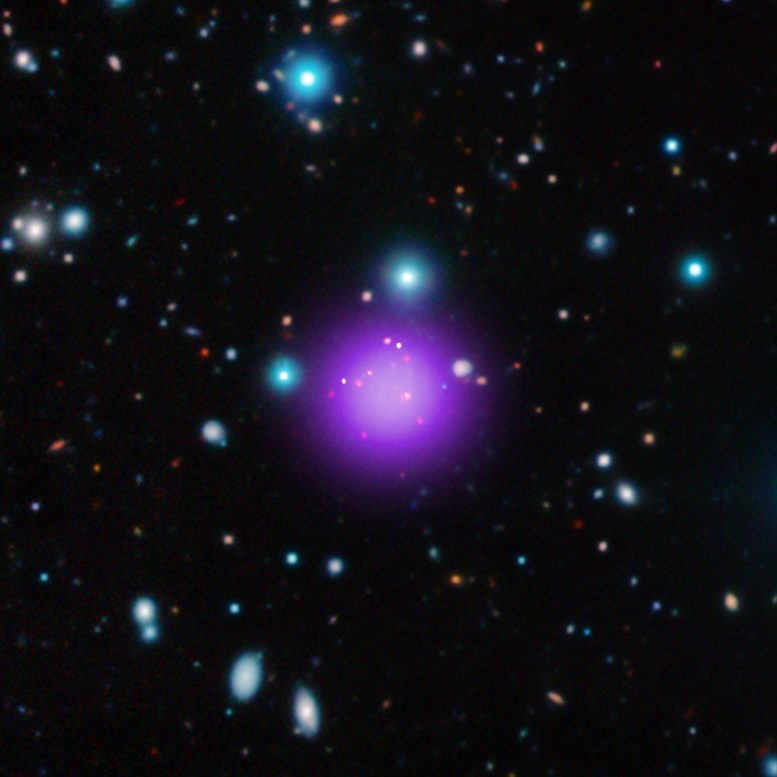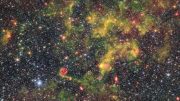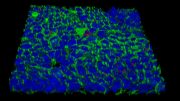
CL J1001+0220 is about 11.1 billion light-years from Earth. It’s the most distant galaxy cluster to date.
Using Chandra and several other telescopes, astronomers have found the most distant galaxy cluster to date. This cluster, called CL J1001+0220, lies about 11.1 billion light-years from Earth and may have been caught right after birth, a brief, but important stage of cluster evolution never seen before.
The remote galaxy cluster was found in data from the COSMOS survey, a project that observes the same patch of sky in many different kinds of light ranging from radio waves to X-rays. This composite shows CL J1001+0220 (CL J1001, for short) in X-rays from Chandra (purple), infrared data from ESO’s UltraVISTA survey (red, green, and blue), and radio waves from the Atacama Large Millimeter/submillimeter Array (ALMA) (green). The diffuse X-ray emission comes from a large amount of hot gas, one of the defining elements of a galaxy cluster, as described in the press release.
In addition to its extraordinary distance, CL J1001 is remarkable because of its high levels of star formation in galaxies near the center of the cluster. Within about 250,000 light-years of the center of the cluster (its core), eleven massive galaxies are found, and nine of those display high rates of formation. Specifically, stars are forming in the cluster core at a rate equivalent to about 3,400 Suns per year.
“This galaxy cluster isn’t just remarkable for its distance, it’s also going through an amazing growth spurt unlike any we’ve ever seen,” said Tao Wang of the French Alternative Energies and Atomic Energy Commission (CEA) who led the study.
The large amount of growth through star formation in the galaxies in CL J1001 distinguishes it from other galaxy clusters found at distances of about 10 billion light-years and closer, where little growth is occurring. These results suggest that elliptical galaxies in clusters may form their stars through more violent and shorter bursts of star formation than elliptical galaxies outside clusters.
The latest study shows that CL J1001 galaxy cluster may be undergoing a transformation from a galaxy cluster that is still forming, known as a “protocluster,” to a mature one. Astronomers have never found a galaxy cluster at this precise stage. These results may also imply that star formation slows down in large galaxies within clusters after the galaxies have already come together during the development of a galaxy cluster.
“It appears that we have captured this galaxy cluster at a critical stage just as it has shifted from a loose collection of galaxies into a young, but fully formed galaxy cluster,” said co-author David Elbaz from CEA.
A paper describing these results appeared in The Astrophysical Journal on August 30, 2016. The authors were Tao Wang (French Alternative Energies and Atomic Energy Commission, or CEA), David Elbaz (CEA), Emanuele Daddi (CEA), Alexis Finoguenov (University of Helsinki), Daizhong Liu (Purple Mountain Observatory, China), Veronica Strazzullo (Ludwig Maximillian University of Munich), Francesco Valentino (CEA), Remco van der Burg (CEA), Anita Zanella (CEA), Laure Ciesla (CEA), Raphael Gobat (Korean Institute for Advanced Study), Amandine Le Brun (CEA), Maurillio Pannella (Ludwig Maximillian University), Mark Sargent (University of Sussex), Xinwen Shu (Anhui Normal University), Qinghua Tan (University of Helsinki), Nico Cappelluti (Yale), and Yanxia Li (University of Hawaii).
Reference: “Discovery of a galaxy cluster with a violently starbursting core at z=2.506” by Tao Wang, David Elbaz, Emanuele Daddi, Alexis Finoguenov, Daizhong Liu, Corentin Schreiber, Sergio Martin, Veronica Strazzullo, Francesco Valentino, Remco van der Burg, Anita Zanella, Laure Ciesla, Raphael Gobat, Amandine Le Brun, Maurilio Pannella, Mark Sargent, Xinwen Shu, Qinghua Tan, Nico Cappelluti and Yanxia Li, 30 August 2016, The Astrophysical Journal.
DOI: 10.3847/0004-637X/828/1/56
arXiv:1604.07404









There are some very complicated issues of galaxy formation. Unfortunately, here is the same problem as with the stars. The origin of galaxies remains unclear, in spite of huge activity in the field. What the “formation” means? It means that we have the material that is assembling into galaxies.